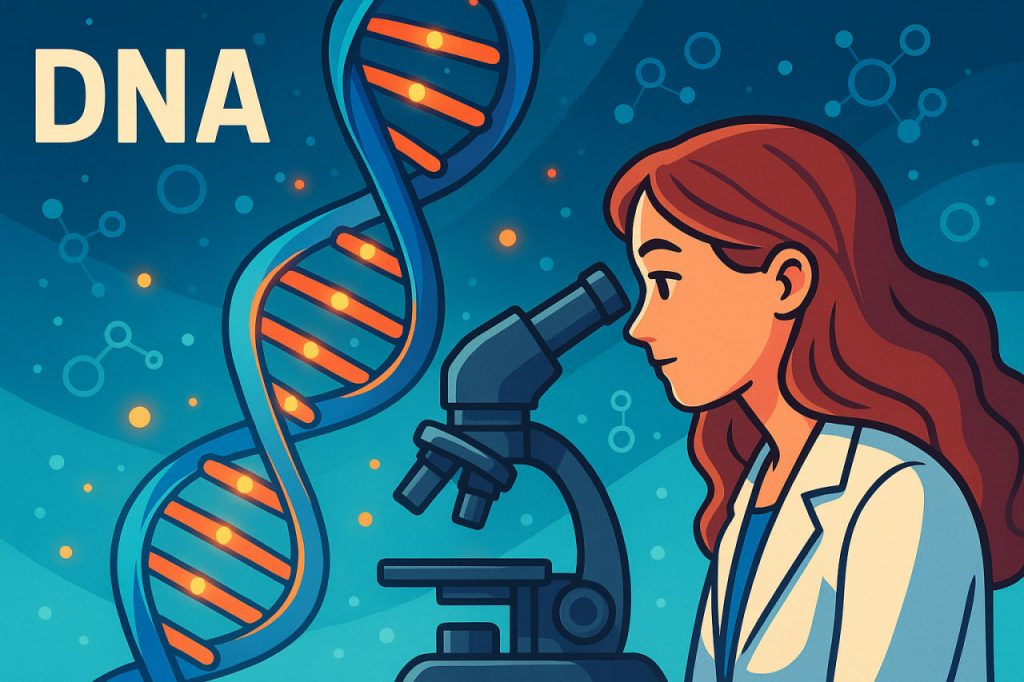Deoxyribonucleic acid, or DNA, is one of the most extraordinary molecules known to science. It carries the genetic instructions that determine how every living organism grows, functions, and evolves. From the color of our eyes to the structure of a tree leaf, DNA shapes all aspects of life. This double-helix molecule, discovered in the mid-20th century, has revolutionized biology, medicine, and technology. Today, DNA stands as both a biological marvel and a key to understanding humanity’s past, present, and future.
The Discovery of DNA
The story of DNA begins in the 19th century when scientists first identified a mysterious substance in cell nuclei. However, its importance wasn’t recognized until 1953, when James Watson and Francis Crick, with contributions from Rosalind Franklin and Maurice Wilkins, revealed the double-helix structure. This discovery marked a turning point in genetics, showing that DNA’s unique spiral shape allows it to store and transmit vast amounts of biological information. Franklin’s X-ray diffraction images were critical to understanding this structure, though her contributions were only fully acknowledged later.
The Structure of DNA
DNA resembles a twisted ladder known as a double helix. The sides of the ladder are made of sugar and phosphate molecules, while the rungs consist of pairs of chemical bases: adenine (A), thymine (T), cytosine (C), and guanine (G). These bases pair specifically—A with T and C with G—forming the code that carries genetic instructions. A complete set of this code is known as the genome. If the DNA in a single human cell were stretched out, it would measure over two meters long, yet it’s intricately coiled inside the nucleus of microscopic cells.
How DNA Works
DNA contains the instructions for building proteins, which perform nearly every function in the body. These instructions are written in sequences of three bases called codons, each corresponding to a specific amino acid. When a cell needs to make a protein, a section of DNA is copied into RNA (ribonucleic acid), which then guides the assembly of amino acids into proteins. This process—called gene expression—determines everything from cell behavior to physical traits. Errors in the DNA sequence, known as mutations, can lead to variation or, in some cases, disease.
DNA in Evolution and Inheritance
Every living organism inherits DNA from its parents. In humans, half of the genetic material comes from the mother and half from the father. Over generations, DNA changes slightly due to mutations and recombination, creating diversity among species. This genetic variation is the foundation of evolution, enabling organisms to adapt to their environments. By comparing DNA sequences, scientists can trace evolutionary relationships between species and even reconstruct ancient human migrations.
The Role of DNA in Modern Science
DNA research has transformed many fields. In medicine, understanding genetic codes helps identify hereditary diseases and develop targeted therapies. In forensics, DNA profiling is used to solve crimes and identify individuals with near-perfect accuracy. Agriculture benefits from DNA technology through genetically improved crops and livestock. Meanwhile, DNA sequencing—decoding the entire genetic blueprint—has opened new frontiers in biotechnology, from gene editing to personalized medicine.
Ethical and Expert Perspectives
Experts agree that DNA research brings enormous potential but also significant ethical challenges. Geneticists like Jennifer Doudna, co-inventor of the CRISPR-Cas9 gene-editing tool, emphasize the need for responsible use of this power. While gene editing can eliminate inherited diseases, it also raises questions about “designer babies” and genetic inequality. Bioethicists argue that regulation and transparency are essential to ensure that DNA technology benefits humanity rather than divides it. Scientists worldwide continue to debate the moral limits of altering the genetic code of life.
The Future of DNA Technology
The future of DNA research lies in precision and possibility. Synthetic biology may allow scientists to design entirely new organisms, while nanotechnology could use DNA as a building material for microscopic machines. DNA-based data storage might soon replace traditional hard drives, as a single gram of DNA can hold more than 200 petabytes of information. These innovations could redefine medicine, computing, and even what it means to be human. The more we learn about DNA, the closer we come to unlocking the full potential of life itself.
Interesting Facts
- If all the DNA in your body were uncoiled, it could stretch from Earth to the Sun and back hundreds of times.
- Human DNA is 99.9% identical from person to person—the remaining 0.1% accounts for all physical differences.
- Some viruses, unlike humans, use RNA instead of DNA to store their genetic material.
- Bananas share about 60% of their DNA with humans.
- The Human Genome Project (completed in 2003) mapped all 3 billion base pairs of human DNA for the first time.
Glossary
- DNA (Deoxyribonucleic Acid) – The molecule carrying genetic instructions for life.
- Double Helix – The spiral structure of DNA discovered by Watson and Crick.
- Genome – The complete set of an organism’s DNA, including all its genes.
- Codon – A sequence of three DNA or RNA bases that codes for one amino acid.
- Mutation – A change in the DNA sequence that can alter gene function.
- Gene Expression – The process by which information from a gene creates a functional product, like a protein.
- CRISPR-Cas9 – A modern gene-editing technology that allows precise modification of DNA.
- RNA (Ribonucleic Acid) – A molecule that helps translate DNA instructions into proteins.
- Synthetic Biology – The design and construction of new biological systems using DNA technology.
- Bioethics – The study of ethical issues arising from advances in biology and medicine.


